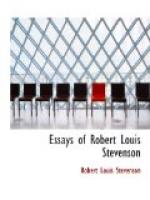English people of the present day[15] are apt, I know not why, to look somewhat down on incident, and reserve their admiration for the clink of teaspoons and the accents of the curate. It is thought clever to write a novel with no story at all, or at least with a very dull one. Reduced even to the lowest terms, a certain interest can be communicated by the art of narrative; a sense of human kinship stirred; and a kind of monotonous fitness, comparable to the words and air of Sandy’s Mull, preserved among the infinitesimal occurrences recorded. Some people work, in this manner, with even a strong touch. Mr. Trollope’s inimitable clergymen naturally arise to the mind in this connection. But even Mr. Trollope[16] does not confine himself to chronicling small beer. Mr. Crawley’s collision with the Bishop’s wife, Mr. Melnette dallying in the deserted banquet-room, are typical incidents, epically conceived, fitly embodying a crisis. Or again look at Thackeray. If Rawdon Crawley’s blow were not delivered, Vanity Fair would cease to be a work of art. That scene is the chief ganglion of the tale; and the discharge of energy from Rawdon’s fist is the reward and consolation of the reader. The end of Esmond is a yet wider excursion from the author’s customary fields; the scene at Castlewood is pure Dumas;[17] the great and wily English borrower has here borrowed from the great, unblushing French thief; as usual, he has borrowed admirably well, and the breaking of the sword rounds off the best of all his books with a manly, martial note. But perhaps nothing can more strongly illustrate the necessity for marking incident than to compare the living fame of Robinson Crusoe with the discredit of Clarissa Harlowe.[18] Clarissa is a book of a far more startling import, worked out, on a great canvas, with inimitable courage and unflagging art. It contains wit, character, passion, plot, conversations full of spirit and insight, letters sparkling with unstrained humanity; and if




